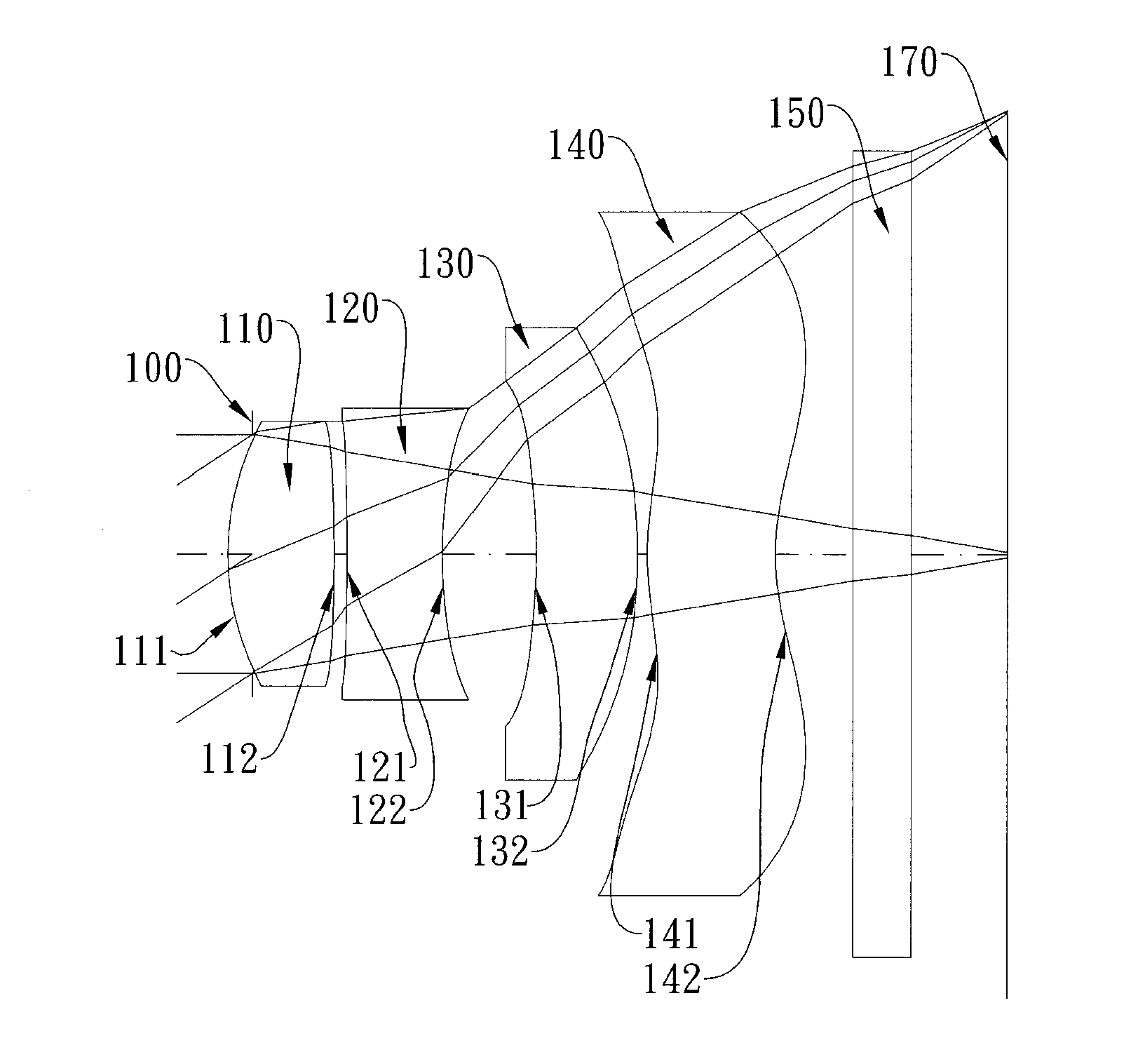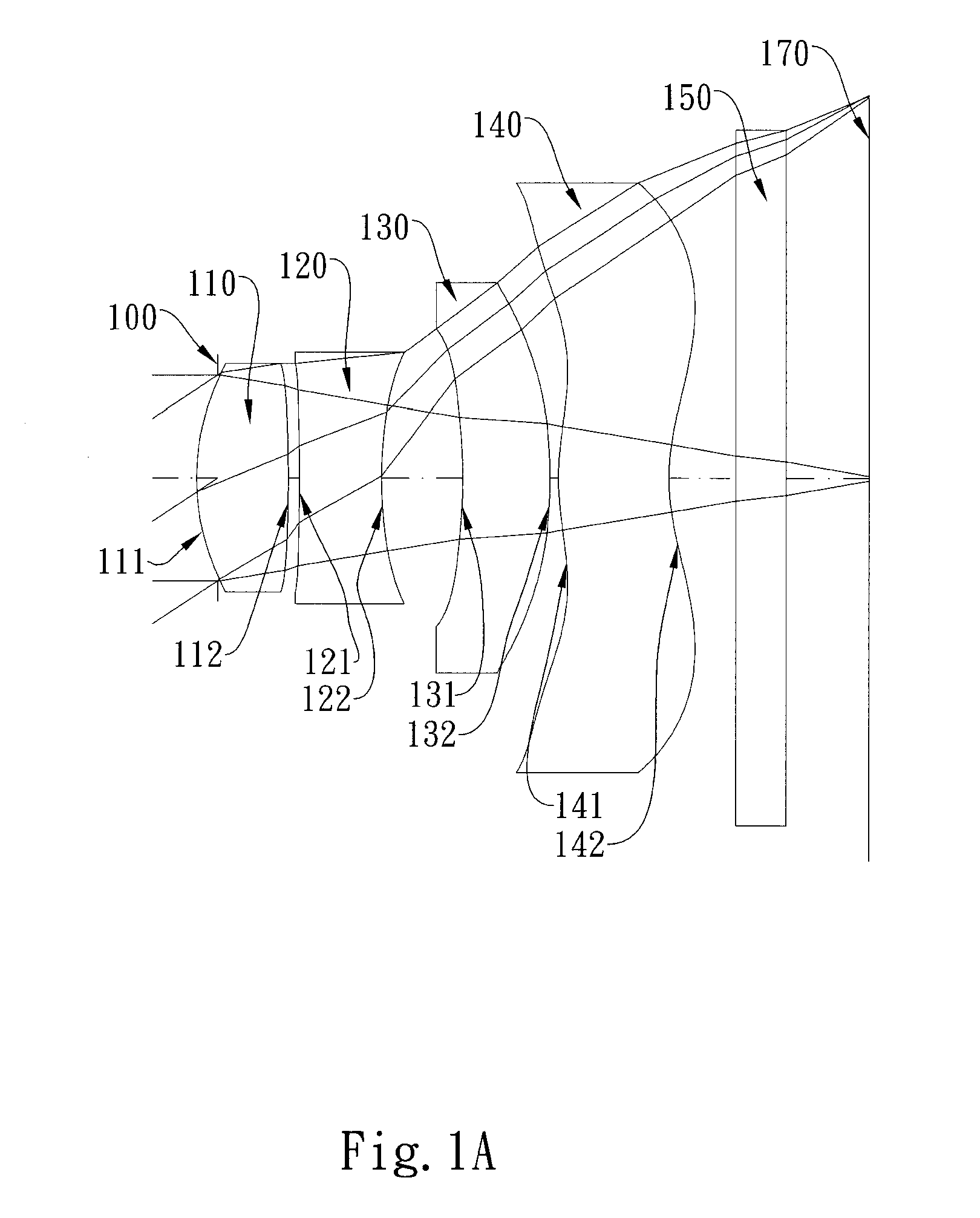Photographing Lens Assembly
a technology of lens assembly and glass lens, which is applied in the field of photographing lens assembly, can solve the problems of complex process of adhesion of glass lens to the lens, the insufficient three-element lens assembly of a high-end imaging lens module, and the inability to reduce the total track length of the system easily, so as to reduce the size of the lens assembly, reduce the sensitivity of the optical system, and improve the effect of resolution
- Summary
- Abstract
- Description
- Claims
- Application Information
AI Technical Summary
Benefits of technology
Problems solved by technology
Method used
Image
Examples
first embodiment
[0083]In the present photographing lens assembly, the focal length of the photographing lens assembly is f, and it satisfies the relation: f=3.46 (mm).
[0084]In the first embodiment of the present photographing lens assembly, the f-number of the photographing lens assembly is Fno, and it satisfies the relation: Fno=2.85.
[0085]In the first embodiment of the present photographing lens assembly, half of the maximal field of view of the photographing lens assembly is HFOV, and it satisfies the relation: HFOV=33.1 deg.
[0086]In the first embodiment of the present photographing lens assembly, the Abbe number of the first lens element 110 is V1, the Abbe number of the second lens element 120 is V2, and they satisfy the relation: V1−V2=32.5.
[0087]In the first embodiment of the present photographing lens assembly, the Abbe number of the first lens element 110 is V1, the Abbe number of the third lens element 130 is V3, and they satisfy the relation: |V1−V3|=0.0.
[0088]In the first embodiment of ...
second embodiment
[0102]In the present photographing lens assembly, the focal length of the photographing lens assembly is f, and it satisfies the relation: f=3.85 (mm).
[0103]In the second embodiment of the present photographing lens assembly, the f-number of the photographing lens assembly is Fno, and it satisfies the relation: Fno=2.85.
[0104]In the second embodiment of the present photographing lens assembly, half of the maximal field of view of the photographing lens assembly is HFOV, and it satisfies the relation: HFOV=30.4 deg.
[0105]In the second embodiment of the present photographing lens assembly, the Abbe number of the first lens element 210 is V1, the Abbe number of the second lens element 220 is V2, and they satisfy the relation: V1−V2=32.5.
[0106]In the second embodiment of the present photographing lens assembly, the Abbe number of the first lens element 210 is V1, the Abbe number of the third lens element 230 is V3, and they satisfy the relation: |V1−V3|=0.0.
[0107]In the second embodimen...
third embodiment
[0121]In the present photographing lens assembly, the focal length of the photographing lens assembly is f, and it satisfies the relation: f=4.27 (mm).
[0122]In the third embodiment of the present photographing lens assembly, the f-number of the photographing lens assembly is Fno, and it satisfies the relation: Fno=2.48.
[0123]In the third embodiment of the present photographing lens assembly, half of the maximal field of view of the photographing lens assembly is HFOV, and it satisfies the relation: HFOV=33.5 deg.
[0124]In the third embodiment of the present photographing lens assembly, the Abbe number of the first lens element 310 is V1, the Abbe number of the second lens element 320 is V2, and they satisfy the relation: V1−V2=32.5.
[0125]In the third embodiment of the present photographing lens assembly, the Abbe number of the first lens element 310 is V1, the Abbe number of the third lens element 330 is V3, and they satisfy the relation: |V1−V3|=0.0.
[0126]In the third embodiment of ...
PUM
 Login to View More
Login to View More Abstract
Description
Claims
Application Information
 Login to View More
Login to View More - R&D
- Intellectual Property
- Life Sciences
- Materials
- Tech Scout
- Unparalleled Data Quality
- Higher Quality Content
- 60% Fewer Hallucinations
Browse by: Latest US Patents, China's latest patents, Technical Efficacy Thesaurus, Application Domain, Technology Topic, Popular Technical Reports.
© 2025 PatSnap. All rights reserved.Legal|Privacy policy|Modern Slavery Act Transparency Statement|Sitemap|About US| Contact US: help@patsnap.com



